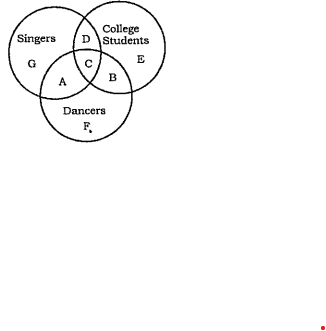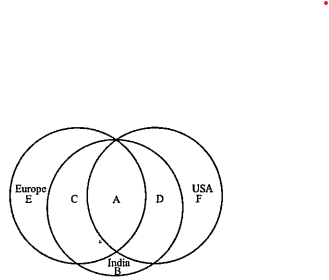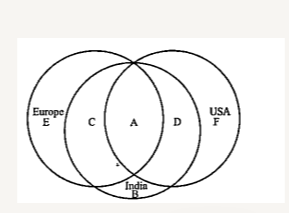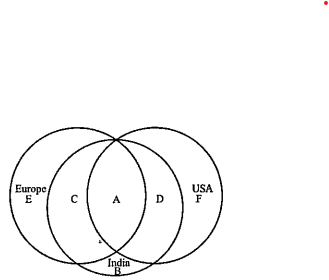Each question below is based on the given diagram. You have to take the given diagram to be true even if it seems to be at variance from commonly known facts and then decide which of the five alternatives following each question logically follows from the given diagram.

Which of the following represents the graduate population which is not employed in BPO?
1) A and B
2) Only C
3) B and D
4) Only D
5) B and E
3,
Topper's Solved these Questions
Similar Questions
You have to take the diagram to be true even if it seems to be at variance from commonly known facts and then decide which of the five alternatives following each question logically follows from the given diagram.

Which of the following represents such dancers who are also singers but not college students ?
1)Only C
2) Only A
3) F and G
4) C and F
5) Only B
View SolutionEach of question given below is based on the given diagram. You have to take the given diagram to be true even if it seems to be at variance with commonly known facts and then decide which of the five alternatives following each question logically follows from the given diagram. The diagram comprises three circles showing people from three different countries who have travelled to either , both or none of the countries mentioned in the diagram.

Which of the following represents those Europeans who have travelled only the USA but not to India?
1) Only C
2) Only A
3) F and C
4) Only D
5)Not illUStrated in the diagram
View Solution
Knowledge Check
In this question some statements are given. You have to consider the statements to be true even if they seem to be at variance from commonly known facts. You have to decide which of the given conclusion, if any, follows from the given statement.
All men are mortal.
Ramu is a man.ANo man is mortalBRamu is mortalCRamu is immortalDAll men are immortalIn the following question one statement is given. You have to answer considering the statement to be true, even if it seems to be at variance from commonly known facts. Statement : Students go to school in uniforms.
AStudents look smart in uniforms.BUniforms are compulsory.CUniforms are easily available.DUniforms create a sense of belongingness.
Each of question given below is based on the given diagram. You have to take the given diagram to be true even if it seems to be at variance with commonly known facts and then decide which of the five alternatives following each question logically follows from the given diagram. The diagram comprises three circles showing people from three different countries who have travelled to either , both or none of the countries mentioned in the diagram.

Which of the following represents Indians who have travelled only to Europe but not to the USA?
1) Only C
2) Only B
3) Only A
4) A and C
5) Only E
View SolutionEach of question given below is based on the given diagram. You have to take the given diagram to be true even if it seems to be at variance with commonly known facts and then decide which of the five alternatives following each question logically follows from the given diagram. The diagram comprises three circles showing people from three different countries who have travelled to either , both or none of the countries mentioned in the diagram.

Which of the following represents such Indians as have travelled only to the USA and not to Europe?
1) Only F
2) Only D
3) A and D
4) D and F
5) C and F
View SolutionBelow are given statements.' You have to take the given statements to be true even if they seem to be at variance with the commonly known facts and then decide which of the given conclusions logically follows from the given statements
Statements
1. All rats are hills.
2. All hills are rivers
View SolutionIn given questions, two / three statements followed by two conclusions numbered I and II have been given. You have to take the given statements to be true even if they seem to be at variance from the commonly known facts and then decide which of the given conclusions logically follow from the given statements disregarding commonly known facts,
Statements: All solutions are problems.
All questions are solutions.
Conclusion I. No question is a problem
II. All question are problems.
(a) Either conclusion I or II is true
(b) Neither conclusion I nor II is true
(c) Both conclusion I and II are true
(d) Only conclusion I is true
(e) Only conclusion II is true
View SolutionDirection: In the question below there are three statements followed by two conclusions I, and II. You have to take the three given statements to be true even if they seem to be at variance from commonly known facts and then decide which of the given conclusions logically follows from the given statements disregarding commonly known facts. Statements:
I. Only few feasts are vultures. II. Only feasts are cards. III. No vulture is veg. Conclusions: I. Some veg are feasts. II. Some feasts are cards.
View SolutionDirection: In the question below there are three statements followed by three conclusions I,II and III. You have to take the three given statements to be true even if they seem to be at variance from commonly known facts and then decide which of the given conclusions logically follows from the given statements disregarding commonly known facts. Statements:
I. Only Ds are Fi. II. All Cv are Ds. III. Few Cv are Qw. Conclusions: I. No Ds is Qw. II. All Fi are Qw.
View Solution
